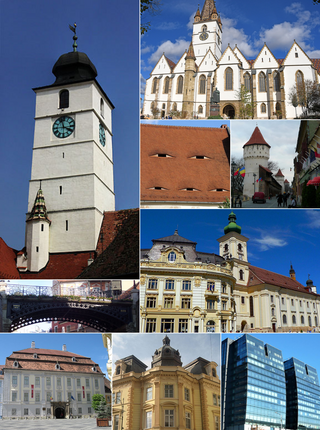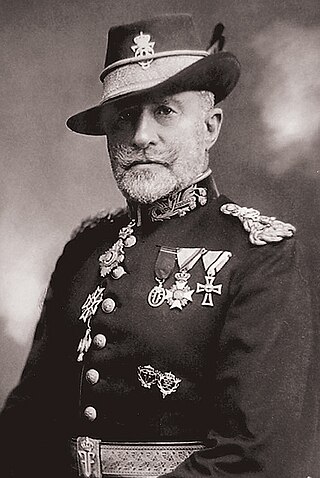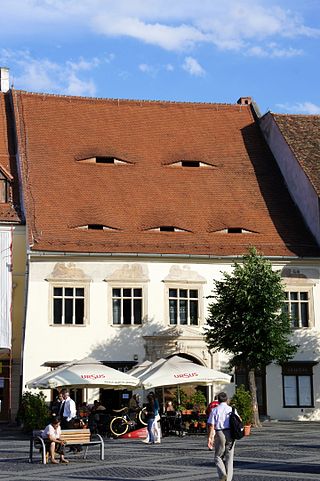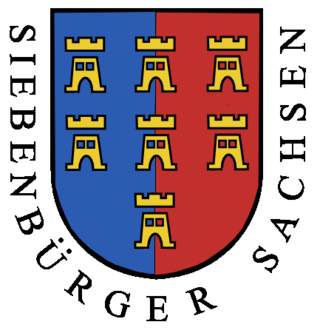
Transylvania is a historical and cultural region in Central and Eastern Europe, encompassing central Romania. To the east and south its natural border is the Carpathian Mountains and to the west the Apuseni Mountains. Broader definitions of Transylvania also include the western and northwestern Romanian regions of Crișana and Maramureș, and occasionally Banat. Historical Transylvania also includes small parts of neighbouring Western Moldavia and even a small part of south-western neighbouring Bukovina to its north east. The capital of the region is Cluj-Napoca.

Sibiu County is a county of Romania, in the historical region of Transylvania. Its county seat is the namesake town of Sibiu.

Sibiu is a middle-sized, well-preserved fortified medieval town in central Romania, situated in the historical region of Transylvania. Located some 275 km (171 mi) north-west of Bucharest, the town straddles the Cibin River, a tributary of the river Olt. Now the county seat of the Sibiu County, between 1692 and 1791 and 1849–65 Sibiu was the capital of the Principality of Transylvania. During the Modern era, the Hecht hause in Sibiu served as the seat of the Transylvanian Saxon University.

The Transylvanian Saxons are a people of mainly German ethnicity and overall Germanic origin; mostly Luxembourgish initially during the medieval Ostsiedlung process, then also from other parts of present-day Germany) who settled in Transylvania in various waves, starting from the mid and mid-late 12th century until the mid 19th century.

Avrig is a town in Sibiu County, Transylvania, central Romania. It has a population of 12,815 and the first documents attesting its existence date to 1346. It officially became a town in 1989, as a result of the Romanian rural systematization program.
Franz-Joseph Müller, Freiherr von Reichenstein or Franz-Joseph Müller von Reichenstein was an Austrian mineralogist and mining engineer. Müller held several positions in the Habsburg monarchy administration of mines and coinage in the Banat, Transylvania, and Tyrol. During his time in Transylvania he discovered tellurium in 1782. In his later career he became a member of the imperial council in Vienna and was knighted and elevated to the rank Freiherr in 1820.

Klaus Iohannis(Romanian: [ˈkla.us joˈhanis], German: [ˈklaʊs joˈhanɪs]; also spelled Johannis ; born 13 June 1959), sometimes briefly referred to as KWI in the Romanian press, is a Romanian politician, physicist, and former physics teacher at Samuel von Brukenthal National College who has been serving as the president of Romania since 2014. He became the president of the National Liberal Party (PNL) in 2014, after previously serving as the leader of the Democratic Forum of Germans in Romania (FDGR/DFDR) between 2002 and 2013. Prior to entering national politics, he was a physics teacher in his native Sibiu.

The Germans of Romania represent one of the most significant historical ethnic minorities of Romania.

Samuel Freiherr von Brukenthal was the Habsburg governor of the Grand Principality of Transylvania between 6 July 1774 and 9 January 1787. He was a personal advisor of Empress Maria Theresa.

Săliște is a town in Sibiu County, in the centre of Romania, 21 km (13 mi) west of the county capital, Sibiu. Declared a town in 2003, it is the main locality in the Mărginimea Sibiului area.
The Democratic Forum of Germans in Romania is a political party organised on ethnic criteria representing the interests of the German minority in Romania.

The Brukenthal National Museum is a museum in Sibiu, Transylvania, Romania, established in the late 18th century by Samuel von Brukenthal (1721-1803) in his city palace. Baron Brukenthal, governor of the Grand Principality of Transylvania has established his first collections around 1790. The collections were officially opened to the public in 1817, making the museum the oldest institution of its kind on the territory of modern-day Romania.

The Lutheran Cathedral of Saint Mary is the most famous Gothic-style church in Sibiu, Transylvania, central Romania. Its massive 73.34 m high steeple is a landmark of the city. The four turrets situated on top of the steeple are said to have been a sign to let foreigners know that the town had the right to sentence to death. It belongs to the Lutheran, German-speaking Evangelical Church of Augustan Confession in Romania.

Col. August Von Spiess, also spelled von Spieß, formally known as Oberst August Roland von Braccioforte zum Portner und Höflein, was an officer, writer, famous hunter and Hunting Master for the Romanian royal court.

The Principality of Transylvania, from 1765 the Grand Principality of Transylvania, was a realm of the Hungarian Crown and from 1804 an Austrian crownland ruled by the Habsburg and Habsburg-Lorraine monarchs of the Habsburg monarchy. After the Ottomans were ousted from most of the territories of medieval Kingdom of Hungary, and after the failure of Rákóczi's War of Independence (1703-1711), the Habsburg dynasty claimed the former territories of the Principality of Transylvania under the capacity of their title of "King of Hungary". During the Hungarian Revolution of 1848, the Hungarian government proclaimed union with Transylvania in the April Laws of 1848. After the failure of the revolution, the March Constitution of Austria decreed that the Principality of Transylvania be a separate crown land entirely independent of Hungary. In 1867, as a result of the Austro-Hungarian Compromise, the principality was reunited with Hungary proper.

Soterius von Sachsenheim is a Transylvanian Saxon noble family originating from the village Stein, in the former Saxon Repser Stuhl administrative division. Among its members were politicians and bureaucrats in the Transylvanian state administration and also army officers, scholars, pastors and artists.

Samuel von Brukenthal National College is a German-language high school founded in Nagyszeben, Transylvania, Kingdom of Hungary, today in Sibiu, Sibiu County, Romania.

The Lutsch House is a historic monument located in the Grand Square of Sibiu, Transylvania, Romania. It uses the code name 143469.91 in the National Archaeological Repertory of Romania.

The Eyes of Sibiu are the iconic eyebrow dormers on the roofs of Sibiu's houses. Sibiu lies in Transylvania, a historical region of Romania. The eyes, which are a symbol and a tourist attraction of the city, have given Sibiu the nicknames of The City with Eyes, The City Where Houses Don't Sleep and the portmanteau Seebiu. They vary in shape – most of them are trapezoid-shaped, others having rounded or elongated forms.

The Transylvanian Saxon University was an official governing body of the Transylvanian Saxon community in Transylvania during the Late Middle Ages up until the late Modern Age. The Saxon University was led by the Saxon Count.


















